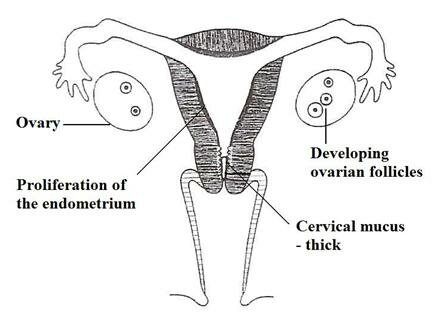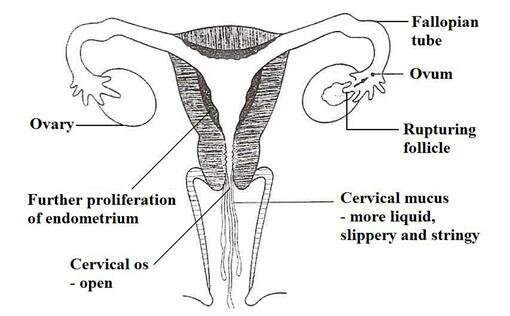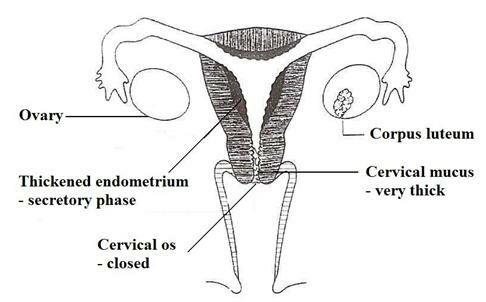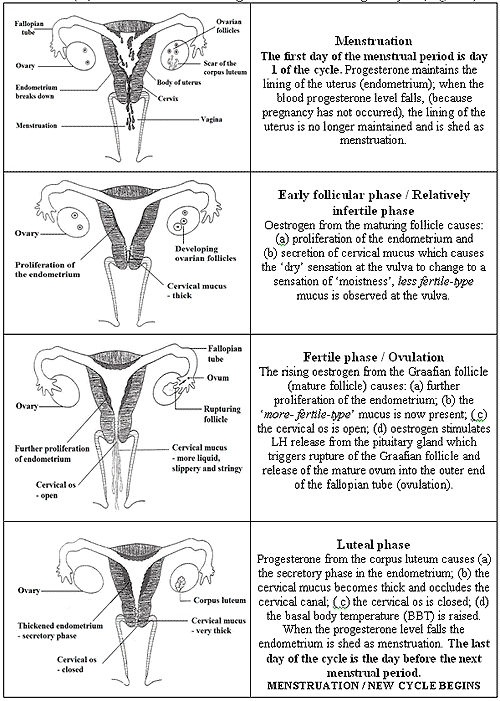THE UTERUS DURING THE CYCLE – Changes in the Endometrium (i.e. the lining of the uterine cavity)
During the menstrual cycle the superficial layer of the endometrium undergoes changes to prepare for possible pregnancy, and these changes are termed the uterine cycle. These cyclical changes in the endometrium can be divided into three phases,
(i) menstrual phase, (Figs.6-8, 6-12)
(ii) proliferative phase, (Figs.6-9, 6-10, 6-12)
(iii) secretory phase. (Figs.6-11, 6-12).
- (a) Menstrual Phase:
During the menstrual phase the superficial layer of the endometrium is discharged as the menstrual flow, (menstruation).
- (b) Proliferative Phase :
In the proliferative phase the endometrial cells proliferate stimulated by oestrogen from the growing follicle (ovum) in the ovary before ovulation, the thickness of the endometrium increases 3-5 fold.(1) The proliferative phase of the endometrium corresponds to the follicular phase of the cycle in the ovary (i.e. when the follicle is developing in the ovary).
- (c) Secretory Phase:
After ovulation the glands in the endometrium become more complex in preparation for implantation of the fertilized ovum (secretory phase of the endometrium). This is due to stimulation from progesterone, secreted by the corpus luteum in the ovary. The secretory phase of the endometrium corresponds to the luteal phase of the cycle (i.e. when the corpus luteum is functioning in the ovary.
THE UTERUS DURING THE CYCLE – Changes in the Uterine Cervix – Role of cervical mucus in achieving pregnancy (Fig. 6-8 to 6-12):
Pregnancy cannot occur without fertile-type cervical mucus. During the menstrual cycle the glands in the crypts of the cervix secrete fertile-type mucus due to the stimulation of oestrogen. (LINK to 11a for cervical mucus). Fertile-type mucus (S mucus) is essential to achieve pregnancy, as it aids sperm transport and survival. (LINK to 11d for Fig. 11-7 picture of fertile-type mucus), (LINK to 11h for Fig. 11-13, S mucus). Cervical mucus is the most important fertility indicator as the discharge of mucus from the vagina can be observed by the woman herself and she knows that it is significant as it indicates that the ovum is developing in the ovary. The cervical mucus changes in quality and quantity during the mucus build-up for the six days or so leading up to ovulation. These changes from ‘less-fertile’ mucus to ‘more-fertile’ mucus can be observed by the woman as a change in sensation at the vulva and a change in appearance of the mucus itself. (LINK to 11b for details on cervical mucus)
THE OVARY AND UTERUS DURING THE PHASES OF THE OVARIAN CYCLE: (menstrual phase, follicular phase, ovulation, luteal phase)
- Menstrual Phase (Figure 6-8): (LINK to Summary of cycle diagram. Fig. 6-12), (LINK to 12a for Fig. 12-1 temperature chart) : Menstruation is the vaginal bleeding that occurs at the end of an ovulatory cycle when fertilization has not occurred, and is due to the drop in oestrogen and progesterone levels in the bloodstream. The first day of the menstrual cycle is the first day of the period, and the last day of the menstrual cycle is the day before the next period. During the cycle the endometrium undergoes changes to prepare for a possible pregnancy, at first from the action of oestrogen before ovulation, (proliferative phase) and after ovulation due to progesterone, (secretory phase). Progesterone maintains the endometrium and when pregnancy does not occur the progesterone level falls causing the endometrium to be shed as the menstrual period. The menstrual bleeding lasts from 3 -5 days.

Menstruation Fig. 6-8: Menstruation is sloughing of the endometrium due to the drop in progesterone secondary to the demise of the corpus luteum. Day 1 of the period marks the beginning of a new cycle when the endometrium will be renewed in expectation of pregnancy in the new cycle. In the left ovary the atretic corpus luteum is shown as a ‘scar’. Some recruited follicles in the ovary are at the pre-antral stage of development. (LINK to 12a for Fig. 12-1 temp. chart)
-
Early Follicular Phase: (Fig. 6-9): [LINK to Summary of cycle diagram. Fig. 6-12]:
In the first few days of the cycle, oestrogen and progesterone levels are low allowing FSH from the pituitary gland to stimulate a few follicles in the ovary to grow. (LINK to 6b for Fig. 6-7 H-P-O axis) Oestrogen from the growing follicles (a) stimulates proliferation of the endometrium to prepare for a possible pregnancy (proliferative phase of the endometrium), (b) oestrogen stimulates the cells in the crypts of the cervix to secrete mucus. The cervical mucus is observed by the woman as a change of sensation at the vulva from one of dryness to one of moistness. This change marks the beginning of the fertile phase of the cycle. The mucus initially is thick and opaque in appearance and breaks on stretching between the fingers – characteristics of ‘less- fertile’ mucus. The presence of cervical mucus whether it is the ‘less-fertile’ or the ‘more-fertile’ type indicates potential fertility. (LINK to 11b for further details of cervical mucus)

Early Follicular Phase Fig. 6-9: In the early part of the follicular phase FSH from the pituitary stimulates growth of a number of follicles in the ovary. The developing follicles secrete oestrogen which causes proliferation of the endometrium and the secretion of mucus [LINK to 11h for Fig. 11-12, L mucus], from the glands in the crypts of the cervix. The woman perceives the presence of the cervical mucus as a sensation of moistness at the vulva or sees a vaginal mucus discharge.
-
Late Follicular Phase and Ovulation(Fig. 6-10), (LINK to Summary of cycle diagram. Fig. 6-12) :
In the ovary one of the developing follicles becomes dominant and continues to grow (Graafian follicle), and the other developing follicles become atretic (atrophy). The rising blood oestrogen level from the Graafian follicle stimulates (a) further growth of the endometrium, (b) the secretion of ‘more-fertile’ type mucus by the cervix so that the sensation at the vulva (the opening of the vagina), (LINK to Fig. 8A-1 diagram of anatomy of vulva), changes from one of moistness to one of lubrication or slipperiness. The appearance of the mucus at the vulva changes from the ‘less-fertile’ thick, opaque mucus, to the ‘more-fertile mucus which is a clear, stretchy and looks like raw egg-white, (spinnbarkeit is the term used for the elasticity of mucus). [LINK to 11d, mucus parameters]. The ‘more-fertile’ mucus transports and nourishes sperm and its presence is a sign of imminent ovulation. (LINK to 11h for Fig. 11-13, S mucus), (c) high oestrogen stimulates luteinizing hormone (LH) secretion by the pituitary gland (LH surge) which lasts about 36 hours. LH triggers the rupture of the Graafian follicle and the release of the mature ovum into the outer end of the fallopian tube and this event is called ovulation (Fig. 6-10).

Late follicular phase and ovulation, Fig. 6-10 : In the late follicular phase one of the developing follicles becomes dominant and is called the Graafian follicle. The rising oestrogen level from the Graafian follicle causes further proliferation of the endometrium, the cervical mucus secretion becomes more fluid and has the characteristics of ‘more-fertile’ mucus. (LINK to 11d for Fig. 11-6 picture of mucus). The woman perceives the presence of the ‘more-fertile’ mucus as a sensation of wetness or slipperiness at the vulva and/or sees a copious vaginal discharge of clear stretchy mucus. The high oestrogen level suppresses further FSH release from the pituitary and stimulates the LH surge from the pituitary which triggers the rupture of the Graafian follicle and the release of the ovum into the outer end of the fallopian tube, i.e. ovulation. (LINK to 6b for Fig. 6-7 the HPO axis)
-
Luteal Phase (Fig. 6-11):
After ovulation, in the ovary the granulosa cells in the wall of the follicle become luteinized and become a small gland called the ‘corpus luteum’ which secretes both oestrogen and progesterone.2 Progesterone causes (a) a decrease in the proliferation of the endometrium, the endometrial glands become more tortuous and glycogen accumulaties in the cells as nourishment for the fertilized ovum.(1) (secretory phase of the endometrium), (b) Progesterone decreases the quantity and the elasticity of cervical mucus,(1) i.e. it causes the oestrogenic mucus discharge to dry up. The woman observes a change in sensation at the vulva to one of dryness and there is no mucus discharge. Progesterone stimulates the secretion of gestogenic G mucus which occludes the cervical canal, (LINK to 11h for Fig. 11-11, G mucus) (LINK to 11b for details on cervical mucus), (c) Progesterone causes a rise in the basal body temperature which is a sign the ovulation has occurred. (LINK to 12a for Fig. 12-1, temperature chart)

Luteal phase, Fig. 6-11: After ovulation, during the luteal phase in the ovary the wall of the ruptured follicle with its granulosa cells becomes the corpus luteum which secretes progesterone. The progesterone from the corpus luteum prepares the endometrium for implantation of a conceptus, (secretory phase of the endometrium). Progesterone stimulates the crypts in the cervix to secrete G mucus which is thick and occludes the cervical canal. (LINK to 11h for diagram of G mucus Fig. 11-11). The cervical os is closed. The woman perceives a sensation of dryness at the vulva and there is no vaginal discharge. Progesterone raises body temperature and is one of the fertility indicators of ovulation.(LINK to 12a temp. chart Fig.12-1) (see below for Summary of changes in the uterus and ovary during the cycle (Fig.6-12)

Summary of changes in the uterus and ovary during the cycle (Fig.6-12)
References:
- Griffin JE, Ojeda SR;’Textbook of Endocrine Physiology 3rd Edition, 1996, pgs 171,172; Oxford University Press, ISBN 0-19-510755-1( pbk)
- Mansfield MJ, Emans SJ; ‘Anorexia nervosa, athletics,and amenorrhea’; Ped. Clinics of North America; Vol 36,No 3, June 1989, 533-549
